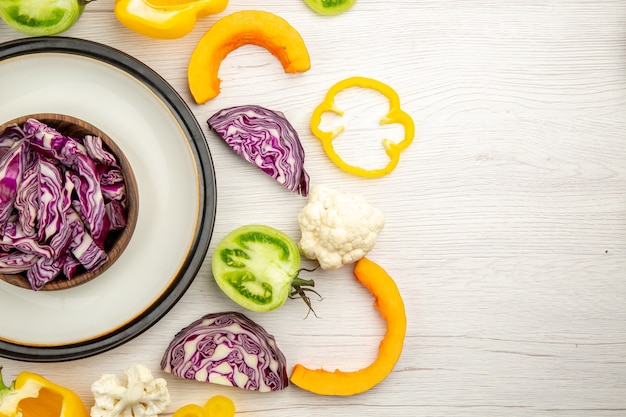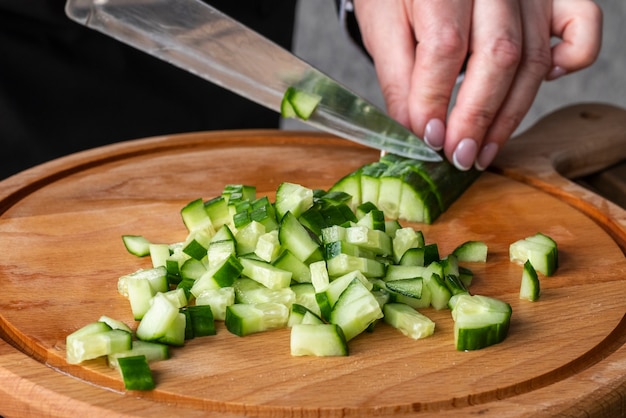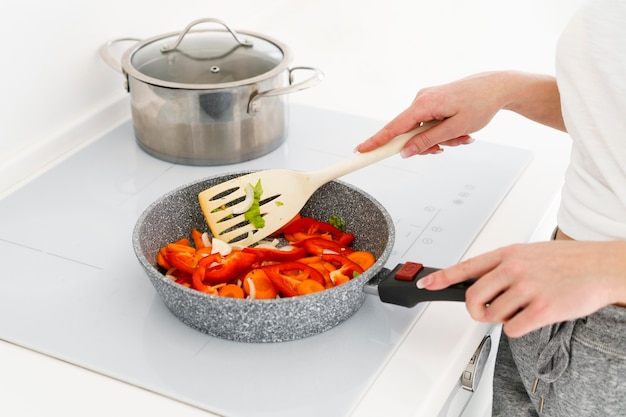Cabbage. It's one of those vegetables that can be a bit intimidating, right? You know it's good for you, packed full of vitamins and minerals, but sometimes it seems like a bit of a chore to cook. Well, I'm here to tell you that cooking cabbage on the stovetop is actually a breeze, and the results can be absolutely delicious. I've been making cabbage dishes for years, and I've learned a few tricks along the way that I'm excited to share with you.
Let's start with the basics. We'll cover everything from choosing the right cabbage to the different ways to cook it. I'll even share some of my favourite recipes that will make you fall in love with this versatile vegetable.
(Part 1) Choosing the Right Cabbage

The first step to a delicious cabbage dish is choosing the right cabbage. You might be surprised to learn that there are quite a few different varieties available, each with its own unique flavour and texture.
Green Cabbage
Green cabbage, or "common cabbage", is the most widely available type. It has tightly packed leaves that are firm and crisp. I love using green cabbage for coleslaw, sauerkraut, and even as a base for hearty soups. It has a slightly bitter flavour, which can be mellowed by cooking. Green cabbage is also a good source of vitamin C and fiber.
Red Cabbage
Red cabbage, also known as "purple cabbage", boasts a vibrant hue and a slightly sweeter flavour than green cabbage. It's a star in salads, where its colour really pops. I also love braising it and serving it alongside roasted meats. Red cabbage is rich in antioxidants and anthocyanins, which are beneficial for heart health. Its vibrant colour comes from these compounds, which also provide a beautiful colour to dishes.
Savoy Cabbage
Savoy cabbage has crinkled leaves that give it a unique texture. It's a bit more delicate than green cabbage, making it a good choice for steaming or sauteing. I like to use Savoy cabbage for lighter dishes, like stir-fries or stuffed cabbage. It has a milder flavour than green cabbage and is a good source of vitamin K.
Napa Cabbage
Napa cabbage, also known as "Chinese cabbage", has long, pale green leaves that are tender and slightly sweet. It's often used in Asian cuisine, but it's also great in salads or stir-fries. It is lower in calories and fat than other types of cabbage and is a good source of vitamins A and C.
Other cabbage varieties
Beyond these common varieties, there are many other types of cabbage, such as Bok Choy, collard greens, and kale. These can be used in similar ways to the other cabbage varieties, but they each have their own unique flavours and textures. Bok Choy is a popular choice in stir-fries and is known for its delicate flavour and crunchy texture. Collard greens are often cooked with beans and ham, and kale is popular in salads and smoothies.
(Part 2) Preparing the Cabbage

Now that you've chosen your cabbage, it's time to get it ready for cooking. The first step is to remove any damaged outer leaves. Then, you can either cut the cabbage into wedges, quarters, or slices, or shred it using a knife or mandoline.
Here are some tips for prepping your cabbage:
- Wash thoroughly: Cabbage can harbour dirt and debris, so make sure to wash it thoroughly under cold running water. You can also soak it in a bowl of water for a few minutes to remove any lingering dirt.
- Remove the core: The core of the cabbage is tough and inedible. You can remove it by cutting out a small circle from the base of the cabbage, or by cutting the cabbage in half and slicing out the core. If you're making shredded cabbage, you can simply discard the core.
- Slice or shred: The way you cut your cabbage will depend on the dish you're making. For coleslaw or stir-fries, you'll want to shred the cabbage. A mandoline can be a great tool for getting thin, even slices. For braising or roasting, you can cut it into wedges or quarters.
(Part 3) Cooking Cabbage on the Stovetop

There are several different ways to cook cabbage on the stovetop. Let's explore the most common methods.
Sauteing
Sauteing is a quick and easy way to cook cabbage. It's perfect for adding to stir-fries, soups, or even as a side dish. Simply heat some oil in a large skillet over medium heat, then add the cabbage and cook until tender-crisp, about 5-10 minutes. I prefer to use a combination of olive oil and butter for a richer flavour. You can also add some aromatics, like garlic, onions, or ginger, for extra flavour. These will add depth to the dish and complement the flavour of the cabbage. For a more intense flavour, try adding a pinch of red pepper flakes.
Steaming
Steaming is a healthy way to cook cabbage, as it preserves its nutrients. To steam cabbage, place it in a steamer basket over a pot of boiling water. Cover the pot and steam the cabbage until tender-crisp, about 5-10 minutes. You can add some herbs or spices to the water for flavour. Try adding a bay leaf, thyme, or a sprig of rosemary for a fragrant steam. You can also steam cabbage with other vegetables like carrots, broccoli, or potatoes for a healthy and delicious side dish.
Boiling
Boiling is another simple way to cook cabbage. Add the cabbage to a pot of boiling water and cook until tender, about 5-10 minutes. You can use the boiling water to make a delicious cabbage soup or broth. A pinch of salt added to the boiling water will help season the cabbage. For a more complex flavour, you can use vegetable broth instead of water. You can also add other ingredients to the boiling water, like onions, carrots, and celery, to create a more flavorful broth.
(Part 4) cabbage recipes: A Taste of Tradition and Innovation
Now, let's move on to some delicious cabbage recipes. I've curated a selection that showcases the versatility of this humble vegetable.
Classic Coleslaw
This is a classic for a reason. It's refreshing, crunchy, and incredibly easy to make. Here's my go-to recipe:
- Shred: Shred one medium green cabbage and one medium red cabbage. You can use a mandoline, food processor, or a sharp knife for this. Aim for thin, even shreds for the best texture.
- Whisk: In a large bowl, whisk together mayonnaise, sour cream, white vinegar, sugar, and salt to taste. You can adjust the amount of each ingredient to your liking. I like to use a combination of mayonnaise and sour cream for a creamy, tangy dressing. You can also use plain yogurt as a lighter alternative.
- Combine: Add the shredded cabbage to the dressing and mix well. Be sure to toss the cabbage gently so that it doesn't become soggy.
- Chill: Refrigerate for at least 30 minutes before serving. This allows the flavours to meld and the cabbage to absorb the dressing.
Braised Red Cabbage
Braised red cabbage is a beautiful and comforting dish. The slow cooking process brings out the cabbage's natural sweetness and creates a tender, melt-in-your-mouth texture. Here's my recipe:
- Caramelize: In a large pot, melt butter over medium heat and add chopped onions and apple. Cook until softened and caramelized. This will create a rich base for the braised cabbage. You can use any type of apple for this, but I prefer Granny Smith for its tartness.
- Add cabbage: Add chopped red cabbage, apple cider vinegar, brown sugar, and salt to the pot. Stir to combine. The apple cider vinegar adds a touch of acidity, while the brown sugar enhances the sweetness of the cabbage.
- Braise: Bring to a boil, then reduce heat to low and cover. Simmer for about 45 minutes, or until the cabbage is tender. During the simmering process, check the cabbage occasionally and add a little more liquid if needed. You can use water, broth, or even apple juice.
- Garnish: Garnish with fresh parsley or chopped walnuts before serving. Parsley adds a fresh flavour contrast, while walnuts provide a crunchy texture.
Spicy Cabbage Slaw with Peanuts
This slaw is a vibrant and flavourful twist on the classic. The peanuts add a crunchy texture, and the spicy sauce is simply addictive. Here's the recipe:
- Shred: Shred one head of napa cabbage and one head of green cabbage. This combination of cabbages creates a balanced texture and flavour.
- Sauce: In a small bowl, whisk together rice vinegar, sesame oil, soy sauce, chili flakes, and honey. You can adjust the amount of chili flakes to your desired level of spice. The honey balances out the spicy and salty flavours.
- Combine: Add the shredded cabbage to the sauce and toss to coat. Be sure to coat the cabbage evenly.
- Top with Peanuts: Sprinkle with chopped peanuts and serve immediately. The peanuts provide a crunchy contrast and a nutty flavour that complements the slaw.
Cabbage and Sausage Soup
This hearty soup is perfect for a cold day. The cabbage adds a sweetness and depth of flavour, while the sausage provides a satisfying richness. Here's how to make it:
- Sauté: In a large pot, sauté chopped onion, celery, and carrots until softened. This creates a flavorful base for the soup. You can use any type of sausage for this, but I prefer italian sausage for its flavour and texture.
- Add sausage: Add your favourite sausage, crumbled, and cook until browned. This will infuse the soup with sausage flavour.
- Add cabbage: Add chopped cabbage, chicken broth, and bay leaves. Bring to a boil, then reduce heat and simmer for 30 minutes, or until the cabbage is tender. You can adjust the amount of broth depending on how thick you like your soup.
- Season: Season with salt, pepper, and thyme before serving. The thyme adds a warm, earthy flavour that complements the other ingredients. You can also add a pinch of red pepper flakes for a touch of heat.
(Part 5) Cabbage and its Health Benefits
Beyond its deliciousness, cabbage is also a nutritional powerhouse. It's packed with vitamins, minerals, and antioxidants. Here are some of the key health benefits of cabbage:
Rich in Vitamins and Minerals
Cabbage is a good source of vitamin C, which supports immunity and skin health. It also contains vitamin K, which is crucial for blood clotting, and vitamin A, which is important for vision and skin health. In addition, cabbage provides a good amount of potassium, which helps to regulate blood pressure. It is also a good source of folate, which is essential for cell growth and development.
Antioxidant Powerhouse
Cabbage is rich in antioxidants, including sulforaphane, which has been shown to have anti-cancer properties. Antioxidants help protect your cells from damage caused by free radicals, which can contribute to a variety of health problems. Other antioxidants in cabbage include vitamin C, vitamin E, and carotenoids. These compounds help fight inflammation and protect against chronic diseases.
Low in Calories and Fat
Cabbage is a low-calorie and low-fat food, making it a great choice for weight management. It's also high in fiber, which helps you feel full and satisfied. One cup of cooked cabbage contains only about 33 calories and 1 gram of fat. The fiber in cabbage also aids in digestion and can help lower cholesterol levels.
(Part 6) cabbage storage Tips
To ensure your cabbage stays fresh and delicious, proper storage is essential. Here are some tips:
Refrigerator Storage
Cabbage can be stored in the refrigerator for up to a week. Wrap it tightly in plastic wrap or store it in a plastic bag. To extend its shelf life, you can also store it in the crisper drawer. The crisper drawer will help maintain humidity levels and keep the cabbage fresh longer.
Freezing Cabbage
You can also freeze cabbage for later use. To freeze cabbage, blanch it in boiling water for 2-3 minutes, then immediately plunge it into ice water. Drain well and package in freezer bags or containers. Frozen cabbage can last for up to 6 months. Blanching helps to preserve the colour and texture of the cabbage. You can freeze cabbage whole or shredded. Frozen cabbage can be used in soups, stews, and other dishes.
(Part 7) Cabbage Beyond the Stovetop
While we've focused on stovetop cooking, cabbage is incredibly versatile and can be used in a variety of other ways. Here are some ideas:
Roasting
Roasted cabbage is a delicious and easy side dish. Cut the cabbage into wedges, toss with olive oil, salt, and pepper, and roast in a preheated oven until tender and caramelized. This method brings out the natural sweetness of the cabbage. You can add other ingredients to the roasting pan, like onions, garlic, or herbs, for additional flavour.
Grilling
Grilled cabbage is a delightful summer treat. Grill the cabbage over medium heat until charred and tender. You can serve it with a simple vinaigrette or a spicy dipping sauce. Grilling adds a smoky flavour to the cabbage. You can also grill cabbage wedges or slices. For a sweeter flavour, try grilling cabbage with a glaze made from honey, soy sauce, and ginger.
Fermenting
Fermented cabbage, like sauerkraut, is a tangy and flavorful food with probiotic benefits. You can make sauerkraut at home using a simple fermentation process. Sauerkraut is a good source of vitamin C and probiotics. It can be enjoyed as a side dish or added to sandwiches and salads. You can also ferment other types of cabbage, like napa cabbage or red cabbage.
(Part 8) Cabbage cooking faqs
To wrap things up, let's address some frequently asked questions about cabbage:
FAQs
| Question | Answer |
|---|---|
| How long does it take to cook cabbage? | The cooking time for cabbage depends on the method you use. Sauteing takes about 5-10 minutes, while steaming or boiling can take 10-15 minutes. Braising can take up to 45 minutes, depending on the recipe. Overcooked cabbage can become mushy, so it's important to cook it until tender-crisp. |
| What are some signs that cabbage is cooked? | When cabbage is cooked, it will be tender and its leaves will soften. It will also lose its raw, pungent smell. The colour of the cabbage may also change slightly as it cooks. |
| Can I cook cabbage with other vegetables? | Absolutely! Cabbage pairs well with many other vegetables, such as carrots, onions, celery, and potatoes. You can also add cabbage to soups, stews, and casseroles. |
| What are some ways to add flavour to cabbage? | You can add flavour to cabbage by using herbs, spices, citrus juices, vinegar, or even a bit of sugar. Garlic, ginger, and onions are also great additions to cabbage dishes. |
| Can I eat cabbage raw? | Yes, you can eat cabbage raw. It's a popular ingredient in salads and coleslaw. Raw cabbage is a good source of vitamin C and fiber. You can also add it to smoothies or juice it. |
I hope this guide has inspired you to explore the world of cabbage. With a bit of creativity, you can create delicious and healthy dishes that will leave you wanting more. So, go ahead and give it a try! You might be surprised by how much you enjoy this humble vegetable.
Everyone is watching

Corn on the Cob: The Ultimate Guide to Perfectly Cooked Ears
Healthy MealsAh, corn on the cob. Just the name evokes images of sunny days, barbecues, and that sweet, juicy flavour that ...

Perfect Pork Roast Oven Cooking Time: A Guide to Delicious Results
Healthy MealsThere's something truly satisfying about a perfectly roasted pork. The aroma alone is enough to make your mout...

Scallops: The Ultimate Guide to Perfect Cooking
Healthy MealsAh, scallops. Those delicate, sweet, and utterly delicious morsels of the sea. They hold a special place in my...

Ham Cooking Time: How Long to Bake, Smoke, or Boil a Delicious Ham
Healthy MealsAh, ham. It's a classic, isn't it? A real crowd-pleaser, especially around holidays. And when done right, it'...

Spaghetti Squash: The Ultimate Guide to Cooking and Serving
Healthy MealsRemember that time you saw spaghetti squash at the supermarket, looking all bumpy and strange, and thought, "W...
